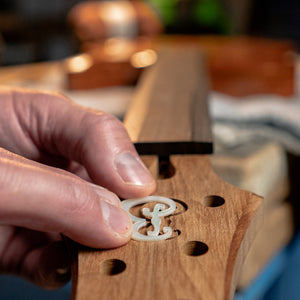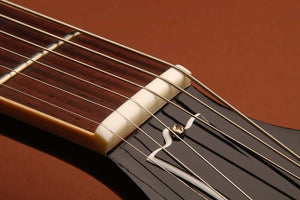
So what makes one guitar stand out from another? There are hundreds of brands and thousands of models of guitars to choose from these days. Whether you're buying your first guitar or you’re a seasoned professional, it’s important to know what your priorities are and what to look for when searching for your next guitar.
With millions of guitars in the universe, odds are there’s a guitar out there that potentially matches your style and playing ability. From used & vintage guitars to boutique and custom guitars, it’s a good idea to prioritize the features that are most important to you and match your playing ability. Soooo... wait, what? An electric guitar should match your playing ability? YES!
While it’s obvious that better players can play almost anything, that doesn’t mean beginners, intermediate, and seasoned players should all play the same guitar. Are we crazy?! Well, not yet, but hear us out...
At first glance, beginners and pros alike, for the most part, all play the same electric guitars. I mean, don’t you own the same guitar that your idols play on stage? Does every Hendrix fan own a Strat? Sure, it only makes sense, right?! Well, let's think about almost any profession and the corresponding tools that are used. A good golfer can hit any set of clubs, but who pays for a custom set? A road biker can ride any bike, but who would buy the finest bike on the market? A professional violinist might play a $30,000 violin. Why? Why are those custom clubs, bikes, and violins worth it? The discerning enthusiast or professional is absolutely capable of using a cheap Strat or a knock-off Les Paul, but there are nuances they appreciate about something more refined and personal to their style and technique. In fact, we all want something that fits our own personal needs.
Endless Options

This is where we tell you that only a custom guitar fits the bill, right? Not exactly. There are literally millions of electric guitars already out in the universe. No matter your budget, experience level, or stylistic preferences, there are plenty of guitars already in existence that may tickle your fancy or get the job done. From vintage guitars and reissues to knock-offs, partcasters*, and DIY kits, you can get the look you want at nearly any price point. That may be true, but how do you sort through all these guitars to find the right one for you? Knowing what’s important, and finding a guitar that matches your experience, aspirations, and style will make your next guitar purchase one that you’ll enjoy for years to come.
At Born Guitars we work with musicians everyday to make sure that their custom guitars fit their exacting specifications, and the options they pick match their playing style, personality, hand size, and most importantly, their tonal goals.
Whether you’re buying your first guitar or a one-of-a-kind custom, we believe there are 3 main aspects that you may want to consider next time you're in the market for an electric guitar: Quality, Feel & Looks.
“ Your budget should not only be relative to your bank account, but also to your experience level.
Quality & Value
In simple terms, your electric guitar is an instrument, and its job is to help you express yourself. It’s no wonder why many guitarists are often lured to a guitar by its looks or because their favorite musician plays an instrument. After all, your guitar is an expression of you and your style. We agree that looks are important, but as a musician, we encourage you to consider what quality of instrument you are looking for first. Is this your first guitar, do you want something you can grow into, is this your ultimate guitar that should last forever, or is it for a collection?
What makes one guitar worth more than another that looks exactly the same? Build quality & materials, production made versus custom made, where it’s from, its history, and collectability (who’s played it or signed it). Like any product, tool, or instrument, there is the cheap model, a mid-grade model, and a high-end model. Cheap products are affordable but have serious shortcomings, mid-grade products are affordable and can last a long time, but are made with average materials and workmanship, and the creme de la creme is designed to last forever, be an heirloom, or meet the expectations of the most discerning individual.

Feel & Playability

Feel and playability are generally associated with the neck design and build quality. Building and finishing an excellent instrument takes great care and experience and the guitar neck is arguably the most important component of your guitar. The guitar neck design determines feel, playability, long-term stability, intonation, and resonance. Every detail of the guitar neck is critical in creating a guitar that plays and feels as good as it looks. The design of a high quality guitar will also ensure that your guitar neck continues to play and feel excellent for years to come.***
| Questions | Considerations |
|---|---|
|
Question #1 - Neck Construction: How is the neck built? Is the design prone to headstock breakage or is it designed to allow for adjustment in the future? |
Consideration #1: Check for stability features integrated such as carbon fiber tone rods, quartersawn woods, and high quality double-action trussrods. |
|
Question #2 - Exposed Fret Tangs: Are there exposed fret tangs? |
Consideration #2: Exposed Tangs will stick out as the neck wood dries and ages. |
|
Question #3 - Fret Ends: Do the fret ends feel soft or sharp? |
Consideration #3: Only the finest guitars will feature advanced fret dressings. |
|
Question #4 - Fretboard Edge: Is the fretboard edge sharp or rounded? |
Consideration #4: Rounded or rolled edges feels nicer and indicates more care in design and construction. |
|
Question #5 - Neck Straightness: Is the neck straight or does it bow? Is this adjustable? Is action high on the upper frets? |
Consideration #5: Make sure to ask or check for fret buzz and string action. If it’s not ideal, check to see if it can be adjusted or if it’s something worse. |
|
Question #6 - Frets Material: Does it have nickel frets or stainless steel? |
Consideration #6: Nickel will wear out over time, S.S. lasts forever but is more labor intensive to install, shape and dress. |
|
Question #7 - Bridge Position: Is the bridge in a normal position? |
Consideration #7: An odd bridge setup (too high off body, or maxed out saddles) can be a sign of an improper neck angle or design, and a sign of intonation issues. |
|
Question #8 - Nut Crafting: Is the nut crafted so that the strings sit half above the top edge and break cleanly at the front edge of the nut? |
Consideration #8: A properly crafted nut ensures proper intonation, string vibration and tuning stability. |
|
Question #9 - Fretboard Thickness: How thick is the fretboard? |
Consideration #9: Cheaper guitars sometimes have very thin fretboards to save money. A thicker fretboard provides better stability. |
|
Question #10 - Neck Attachment: How is the neck attached? |
Consideration #10: Wood screws are the cheapest and least effective way to attach a guitar neck. A Weak or Loose Neck joint decreases sustain and resonance of you guitar. |
|
Question #11 - Neck & Body Gaps: Are there gaps between the neck and the body? |
Consideration #11: High quality quality guitars will have a strong neck joint that allows energy from the strings to ring through the neck into the guitar body. |
|
Question #12 - Customizable: Is the Guitar Customizable in Anyway? |
Consideration #12: Find out if the customizations are solely visual or if they allow for changes in playability and tone. |
Takeaway: By focusing on these critical factors, you'll find a guitar that not only enhances your playing experience but also grows with you as a musician. This thoughtful approach to selecting an instrument will lead to a more satisfying and enjoyable journey in your musical endeavors

Looks
Do you like a color, sparkle, natural wood or maybe a burst finish?
Do you like a single cutaway or double cutaway look?
Do you like subdued elegance or bright and flashy colors?
Do you like simplicity or lots of fancy details?
Do you want it to match or go with any other equipment or vibe?
Are there any unique features you would like to add?




What Do You Want?
Overwhelmed? Why not go straight to the source?!? 💡
Your luthier has built a multitude of guitars, and they will know how to guide you through any decision you’re unsure of. They should also be able to make suggestions based on your preferences, and your luthier can tell you about features you might not even know are available. At Born Guitars we believe that a custom design should be a fun experience, and each custom build provides the opportunity to express yourself and your creativity.
- Explore Custom Options with our Guitar Builder.
- Start a conversation with our Head Luthier and Schedule a call today.
Final Thoughts
- Does the guitar you’re eying have nice ergonomics?
- How heavy is it?
- How is the neck designed?
- Will it stay in tune and maintain good action throughout the season?
* Partcaster is slang for a guitar that is built from outsourced parts. The most common part-casters are Fender style guitars because there are a ton of aftermarket bodies, necks and other parts available to either retrofit existing Fender style guitars or build a complete guitar from ordered parts. In 2024 the most common partcasters are strat, tele and offset style guitars.
** Born Guitars necks are ultra stable, but changing string gauges or climates may require small adjustments to your guitar’s intonation, truss rod, bridge and nut.
***Simply instrument maintenance will improve the life and performance of your guitar regardless of it’s build quality. Higher quality guitars tend to require less maintenance since their necks are generally more stable due to better designs, materials, and construction. Other features such as bound frets, stainless steel frets, custom neck shapes and quality fret dressings will create improved long-term feel and playability.










